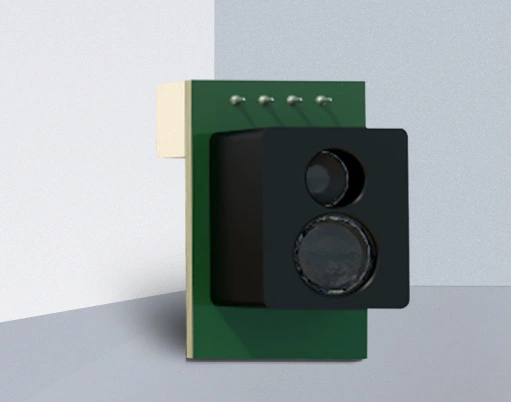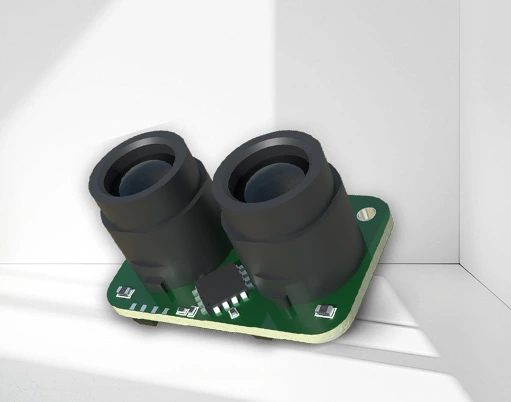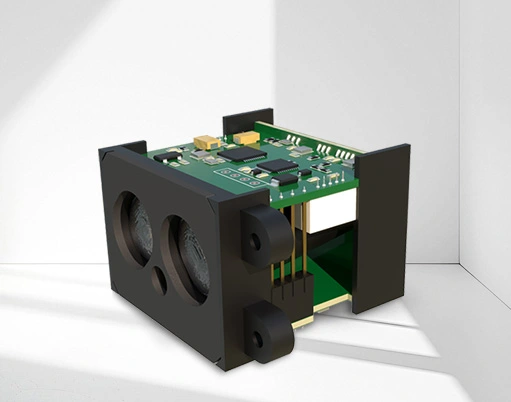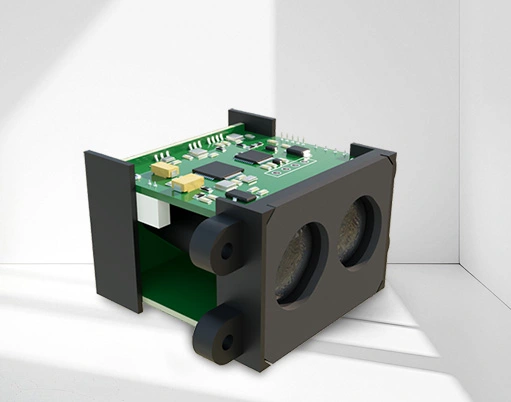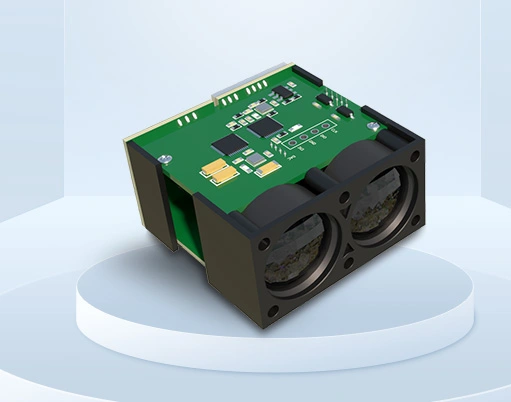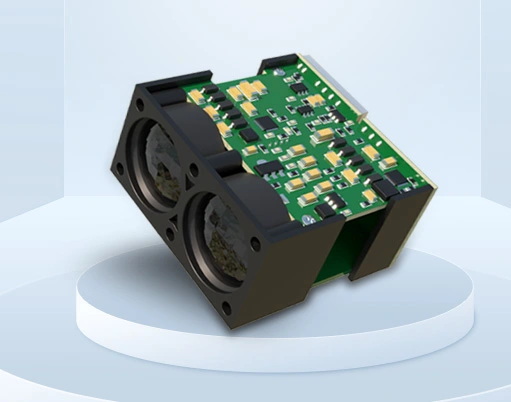
In industrial automation production, the installation integrity of bolts and nuts directly affects product quality and safety performance. Laser triangulation sensors have become an ideal solution for detecting the presence of bolts and nuts due to their advantages of non-contact measurement, high precision, and high response speed. The core principle is to quickly distinguish between the two states of "installed in place" and "missing" by capturing the distance changes on the surface of the object, which is widely used in high-precision scenarios such as automotive assembly, mechanical manufacturing, and electronic equipment production. 1、 Detection principle: Using distance difference to achieve state recognition. The work of laser triangulation distance sensor is based on optical triangulation geometry model: the laser beam emitted by the sensor irradiates the surface of the measured object at a fixed angle, and the reflected light is focused by the receiving lens to form a spot image on the photodetector (CCD/CMOS). When the height of the object being measured changes, the position of the light spot on the detector will be offset. By calculating the correspondence between the offset and the distance, the distance between the object surface and the sensor can be accurately determined. In the detection of bolts and nuts, this distance change becomes the basis for judgment: if the bolt/nut has been installed, its head will be higher than the surface of the workpiece to form a protrusion, and the distance value measured by the sensor is relatively small; If there is a missing item, the measured position is on the plane of the workpiece and the distance value is relatively large. By setting distance thresholds for two states, the sensor can complete its presence determination within milliseconds. For example, in the assembly of car chassis, after installing M10 bolts, the head is 5mm higher than the panel. The sensor can determine whether the bolt exists by recognizing the distance difference of this 5mm. 2、 Construction of Detection System: Collaborative Design of Hardware and Software
Selection of core sensors for hardware system composition: The model with parameter adaptation needs to be selected according to the detection scenario. The recommended measurement range is 5-300mm (covering most industrial bolt installation heights), with a resolution of ≥ 0.01mm (ensuring differentiation of small height differences), and a sampling frequency of ≥ 1kHz (meeting the high-speed detection requirements of the assembly line). For example, the Keyence LK-G series sensors can achieve a resolution of 0.005mm, making them suitable for precision detection. Mechanical positioning device: The sensor is fixed by a gantry or robotic arm to ensure that the laser beam is vertically aligned with the center of the bolt (with a deviation of ≤ 0.5mm). For dynamic detection of assembly lines, a synchronous encoder is required to match the sensor with the rhythm of the workpiece movement. Auxiliary modules: including shading hood (reducing ambient light interference), blowing and cleaning device (preventing dust from adhering to the lens), industrial grade PLC (data processing and logic control), and alarm device (sound and light prompt missing status).
Software algorithm supports benchmark calibration module: establishing distance benchmarks for "existence" and "absence" through standard workpieces. For example, collect the bolt distance values of 100 qualified parts and take the average value as the "existence benchmark" (such as 22.5mm); Collect the planar distance values of 100 blank pieces as the "missing reference" (e.g. 27.5mm), and set a tolerance range of ± 0.3mm. Filtering and noise reduction processing: Adopting the sliding average filtering algorithm (taking the average of 5 consecutive acquisitions) to eliminate instantaneous errors caused by metal surface reflection or vibration, ensuring data stability. Logical judgment unit: Real time comparison of measured values with reference thresholds. When the distance falls within the range of "existing reference ± 0.3mm", it is judged as "existing". When it falls within the range of "missing reference ± 0.3mm", it is judged as "missing". If it exceeds the range, it is marked as "abnormal" (requiring manual rechecking). 3、 Detection process: full process implementation from calibration to online judgment
Pre calibration and parameter setting positioning calibration: Place the workpiece with standard bolts at the testing station, manually adjust the sensor position to make the center of the laser spot coincide with the center of the bolt head (deviation ≤ 0.2mm), ensuring accurate measurement points. Benchmark value collection: Continuously measure the bolt distance and blank distance of the standard part 50 times, remove the 3 maximum and minimum values, take the average, and store it in the system as the benchmark parameter. Threshold optimization: Adjust the tolerance range according to the bolt specifications, for example, if the height deviation of the M6 bolt head is small, the tolerance is set to ± 0.2mm; for large flange nuts, the tolerance can be relaxed to ± 0.5mm.
Online detection and workpiece positioning: The workpiece to be detected is sent to the detection position through a conveyor belt, and the position is fixed by a positioning pin or vision system (repeated positioning accuracy ≤ 0.1mm) to avoid measurement point deviation caused by workpiece offset. Batch detection: For multi bolt workpieces (such as engine cylinder blocks), sensors scan each bolt position sequentially according to preset coordinates through a robotic arm, or parallel detection is achieved using a multi-sensor array, with a single detection time controlled within 0.5 seconds. Result feedback: Qualified workpieces are released with a green light, while missing workpieces trigger a red light alarm and pause the production line. At the same time, the missing position (such as "the second bolt in the third row is missing") is marked on the display screen for workers to quickly replenish. 4、 Optimization Strategy: Technical Solutions for Dealing with Complex Scenarios
Anti interference design and reflection suppression: The surface of metal workpieces is prone to specular reflection, causing overexposure of light spots. Reflection interference can be reduced by installing polarizing plates or adjusting the sensor angle (15 ° -30 ° to the normal). Environmental adaptation: In high-temperature environments (such as engine hot end detection), use temperature resistant sensors (working temperature -40 ℃~85 ℃); Scenes with high levels of dust require automatic blowing and cleaning of the lens every hour to avoid a decrease in measurement accuracy.
Dynamic compensation for precision improvement measures: For small deformations caused by vibration in thin workpieces, a planar model is established through multi-point measurement, and the distance value of a single bolt is compared with the plane of the area to eliminate misjudgment caused by overall deformation. Adaptive threshold: The system automatically calibrates the reference value after detecting 1000 workpieces, compensates for sensor drift (usually ≤ 0.01mm/hour), and ensures long-term detection accuracy. The laser triangulation sensor provides an efficient solution for detecting the presence of bolts and nuts by accurately capturing distance changes. Compared to traditional manual visual or mechanical contact detection, its detection efficiency is improved by 5-10 times, with a misjudgment rate of less than 0.1%, significantly reducing quality risks on the production line. With the promotion of Industry 4.0, the combination of this technology with machine vision and industrial Internet will realize the upgrading of multi-dimensional quality monitoring from existence detection to installation angle, tightening degree, and further promote the development of intelligent manufacturing.

